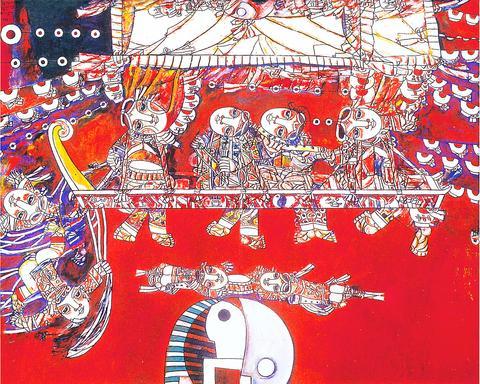An attack of glaucoma 35 years ago could have ended Chiang Han-tung's (
Deprived of clear vision, his painting career stalled, Chiang suffered severe depression and vowed never to pick up a brush again. Fortunately he changed his mind, otherwise we would not have the chance to see some engaging Chinese folk customs brought to life through Chiang unique perspective.
Simply titled Oil Paintings by Chiang Han-tung, (

PHOTO COURTESY OF APOLLO ART GALLERY
This is one of only a few solo exhibitions Chiang has held and the first since his retrospective in 1997.
Chiang was a student of Lee Chun-shang (李仲生), one of Taiwan's most influential painters and fine arts teachers.
In the 1950s, when Impressionism dominated Taiwan's art scene, Chiang was pioneering the Cubist idioms while promoting prints valued as art rather than just as decorations.
Chiang's folk-activity-themed paintings suggest a strong association with painter Wu Hao (
Unlike Wu, who established his reputation early, as indeed did many of his students, Chiang has remained a relatively obscure figure over the past 30 years.
Sporadically appearing in some joint exhibitions, Chiang did not receive any formal recognition until 1997, when he received the Lee Chung-sheng Foundation Modern Painting Award at the age of 68.
The fact that Chiang is not well-known is partly due to his dislike of promotion and avoidance of social activities. Painting is Chiang's one and only passion in life.
Chiang's glaucoma got the better of him just when his career was taking off in 1968. His wood cuts at the time show much influence from Chinese Buddhist frescos, Hindu folk art and, most of all, a vivid expression of an idyllic life from a bygone age.
At the encouragement of his wife, who had to work several jobs to support their life, Chiang broke his vow four years after he put down his easel. At first, he tried to draw with black magic markers, going on to use more colors and finally began using oil on canvas. With his limited eyesight, Chiang can only paint in the soft light of early morning and for no more than a few hours a day.
Spending most of his days painting and thinking, Chiang attributes his paintings to imagination stimulated by the memories of his early life in China's Fujian province. Circuses, religious festivals and the folklore Chiang's elders passed down to him are put down on canvas with childlike simplicity.
Oil Paintings by Chiang Han-tung will show at the Apollo Art Gallery, 2F, 218-6, Chunghsiao E Rd Sec 4 (

In the March 9 edition of the Taipei Times a piece by Ninon Godefroy ran with the headine “The quiet, gentle rhythm of Taiwan.” It started with the line “Taiwan is a small, humble place. There is no Eiffel Tower, no pyramids — no singular attraction that draws the world’s attention.” I laughed out loud at that. This was out of no disrespect for the author or the piece, which made some interesting analogies and good points about how both Din Tai Fung’s and Taiwan Semiconductor Manufacturing Co’s (TSMC, 台積電) meticulous attention to detail and quality are not quite up to

April 21 to April 27 Hsieh Er’s (謝娥) political fortunes were rising fast after she got out of jail and joined the Chinese Nationalist Party (KMT) in December 1945. Not only did she hold key positions in various committees, she was elected the only woman on the Taipei City Council and headed to Nanjing in 1946 as the sole Taiwanese female representative to the National Constituent Assembly. With the support of first lady Soong May-ling (宋美齡), she started the Taipei Women’s Association and Taiwan Provincial Women’s Association, where she

It is one of the more remarkable facts of Taiwan history that it was never occupied or claimed by any of the numerous kingdoms of southern China — Han or otherwise — that lay just across the water from it. None of their brilliant ministers ever discovered that Taiwan was a “core interest” of the state whose annexation was “inevitable.” As Paul Kua notes in an excellent monograph laying out how the Portuguese gave Taiwan the name “Formosa,” the first Europeans to express an interest in occupying Taiwan were the Spanish. Tonio Andrade in his seminal work, How Taiwan Became Chinese,

Mongolian influencer Anudari Daarya looks effortlessly glamorous and carefree in her social media posts — but the classically trained pianist’s road to acceptance as a transgender artist has been anything but easy. She is one of a growing number of Mongolian LGBTQ youth challenging stereotypes and fighting for acceptance through media representation in the socially conservative country. LGBTQ Mongolians often hide their identities from their employers and colleagues for fear of discrimination, with a survey by the non-profit LGBT Centre Mongolia showing that only 20 percent of people felt comfortable coming out at work. Daarya, 25, said she has faced discrimination since she